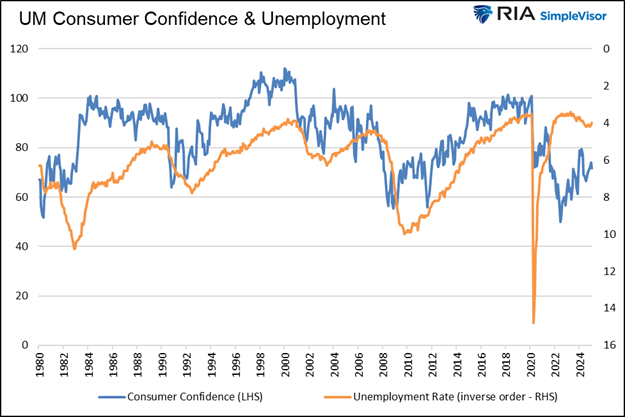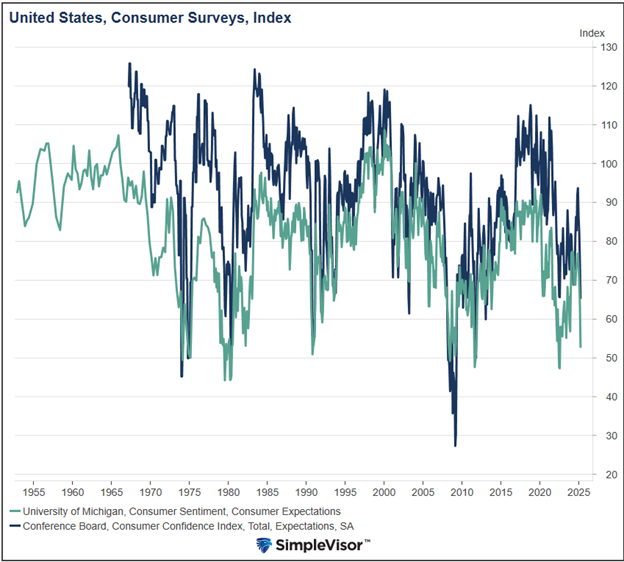We are big fans of Sunday crossword puzzles, which tend to be bigger and more challenging than the weekday format. Adding to their allure, most Sunday puzzles have a clever theme, typically three or four clues whose answers stretch across the puzzle. Solving the theme often makes a complex puzzle a little easier. Like a crossword puzzle, President Donald Trump has been bombarding the media with clues about his economic policy, particularly his plans to fight inflation and reduce interest rates.
Given the importance of inflation and interest rates to the economy and the financial markets, it’s worth assessing his clues and formulating some answers about what Donald Trump may be up to.
Markets Aren’t Blue Or Red
Given the heated political climate in this country, we share some investment advice before we try to solve Donald Trump’s economic puzzle.
As voters and citizens, we should discuss and debate the merits of Trump’s objectives and the tactics he uses to try and achieve them.
As investors, we must remove our political opinions and feelings from the investment decision-making process.
This advice applies to investors spanning the political spectrum. It’s not easy to separate your feelings from your investment outlook. Still, it’s vital if you want to minimize behavioral traits that can harm your ability to grow wealth.
Solving Trump’s Puzzle
We start with a question and two quotes to help solve Trump’s economic puzzle.
- What are the two primary factors that drive inflation?
- “I will very quickly deflate. We are going to take inflation, and we are going to deflate it. We are going to defeat inflation.” –Donald Trump
- “The President wants lower rates. He and I are focused on the 10-year Treasury and what is the yield of that.” -Treasury Secretary Scott Bessent
Clue #1: How Can The President Slow Personal Consumption?
The administration is taking significant steps to reduce federal spending. Among those is trimming the federal workforce. It is estimated that between 200,000 and 300,000 government jobs are at risk.
However, those jobs may be the tip of the iceberg. We have seen numerous estimates claiming the private sector could lose two to three jobs for each federal job. Moreover, the potential lost jobs in fields that are not as closely related in a business sense should be considered. These are businesses like childcare and restaurants that rely on the spending of those employees.
In addition, we need to ponder all the private sector jobs that cuts in federal spending could impact. For instance, the Brookings Institute estimates that 7.5 million private sector jobs are tied to federal contracts and grants.
The potential economic impact goes well beyond the loss of federal jobs and the consumption of those directly affected. Equally critical, job losses threaten consumer confidence, even for those not at risk of losing a job. Moreover, consumer confidence has a significant impact on personal consumption, which represents two-thirds of economic activity. Not surprisingly, consumer confidence and spending are closely related.
The graph below charts the correlation between consumer confidence and the unemployment rate. We display the unemployment axis in reverse order to better show the relationship.
Answer #1 – Reduce Demand
What is one of the two primary drivers of inflation? The answer is demand.
What will cause inflation to decline? The answer is less demand.
What will push interest rates lower? The answer is less demand.
“We’re seeing the hangover from the excess spending in the Biden 4 years. In 6 to 12 months, it becomes Trump’s economy.” –Treasury Secretary Scott Bessent.
This quote leads us to believe the administration thinks job cuts will weaken the economy. Reducing demand for goods and services should cause inflation and interest rates to decline.
Importantly, changes in demand can be sudden, as will their economic impact.
Treasury Secretary Bessent is likely trying to get ahead of the media and blame Joe Biden for what may be an economic slowdown or even a recession.
Clue #2: How Might The President Help Put More Goods and Services Into The Economy?
Consider the following quotes from Donald Trump:
To turbocharge our economy: we have launched the most aggressive deregulation program in history and will be seeking the largest tax cuts in American history.
Under the Trump administration, there will be no better place on Earth to create jobs, build factories, or grow a company than right here in the good old USA.
The new Trump tax cuts will also include 100% expensing for new factory construction in the United States.
Those quotes and many others further reveal Trump’s economic agenda. He wants to revitalize domestic industry through tax reductions and looser regulations, among other policy choices.
Answer #2 – Increase Supply
What is the second of the two primary drivers of inflation? The answer is supply.
What will cause inflation to decline? The answer is less demand coupled with more supply.
What will push interest rates lower? The answer is less demand coupled with more supply.
Tax cuts, deregulation, and a generally more business-friendly environment promote capital spending and expansion by US businesses. Furthermore, Trump is proposing to loosen banking regulations. Doing so makes it easier for banks to fund these companies and make expansion more feasible.
If enacted, these actions should increase the supply of goods and services over time. However, unlike the demand side of the inflation equation, supply-side policies take longer to impact the economy.
Supply And Demand
Considering our two big thematic answers, supply and demand, we can better understand how the economy and inflation may transpire under Donald Trump.
Consumer sentiment, an important factor affecting the demand for goods and services, falters as confidence in wages and job prospects wane. As we wrote, changes in demand can happen quickly. Initially, weaker personal consumption will lead to lower inflation and interest rates. A recession is certainly possible, and as we note, Bessent may already be setting the table for such a scenario. Consider the graph below for historical context regarding current consumer sentiment levels.
We suspect the Fed will react with lower interest rates, end QT, and eventually enact QE to counter economic weakness. If the plan goes well, the Fed’s liquidity buffer can help support the economy and financial markets until the benefits of looser regulations and lower taxes take hold.
As the economic recovery starts, demand will increase. However, supply will also increase due to the benefits of Trump’s policies. Increased production will likely keep a lid on inflation, thus helping keep interest rates down.
The one-two punch of demand decreasing today and supply increasing tomorrow may help Trump meet his lower inflation and interest rate objective. Furthermore, it may also help him achieve his macro plan of taking the keys of the economic engine from the government and giving it to the private sector.
So, unlike solving a crossword puzzle with definitive answers, Trump’s puzzle has many potential answers. Furthermore, economic and geopolitical challenges can easily cause the agenda to change.
Our advice: buckle up. As Trump’s policies impact the economy, it will likely experience turbulence. Disinflation or deflation may be possible alongside weak economic growth or a recession. The upside is not only lower inflation but also reduced interest rates.
There is no guarantee that this will work as we lay out or as the President expects. However, understanding the game plan helps us appreciate how the administration will likely steer policy and impact the various asset classes and their subsectors that we invest in.
